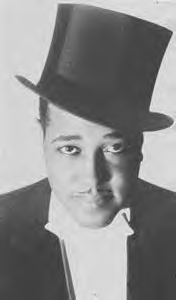|
The Harlem Renaissance
and Duke Ellington

Early in the 1920's, Harlem became the center of a cultural revolution. At the forefront of this new culture was the musical movement that later became known as Jazz. Arriving on the coattails of Ragtime music, made popular by Scott Joplin, Jazz changed the appearance of music forever with its arrival in 1895. Jazz became popular in its birthplace of New Orleans, but took off in popularity with the arrival of the first recorded Jazz album in 1917. This revolutionary form of expression quickly became the "soundtrack of the modern world" (Video on Jazz). As word spread of the cultural rebirth in Harlem, the Jazz movement became centrally located there. Harlem nightclubs almost immediately became packed and people flocked to the nightlife scene of Harlem to hear this amazing new trend of music. Because of the Harlem Renaissance, "African American musical styles became a dominant force in 20th century music," says Scott Alexander, author of the "Red Hot Jazz Archive" (Alexander 1).
Additionally, it was due to the work of a number of individuals that the Jazz movement became popular. Artists such as Jelly Roll Morton , Joe "King" Oliver, and Buddy Bolden characterized the beginning periods of the Jazz movements, however, the contributions of artists and composers such as Louis "Satchmo" Armstrong and Edward "Duke" Ellington have stood the tests of time and racial barriers (Steib 222). When Miles Davis was asked where he drew his inspiration for his monumental work Birth of the Cool, he replied, "Birth of the Cool came from Black musical roots. It came from Duke Ellington." (qtd. in Bergerot 118). Above all other contributors to the Jazz movement, it is impossible to neglect the contributions of Duke Ellington.
According to Scott Alexander, "Duke Ellington brought a level of style and sophistication to Jazz that it hadn't seen before." (Alexander 3). Very similarly to Jelly Roll Morton, the Duke preferred to be considered a composer and arranger rather than an instrumentalist (Alexander 3). He began his Jazz career in Washington D.C. in 1917, but simultaneously made several attempts to join the mainstream Jazz movement in Harlem. However, he was not successful until 1923 when he and a group of his D.C. friends moved to Harlem together.
Together, and with the enlisted help of banjoist Elmer Snowden, they formed the Washingtonians. However, it was not until Ellington joined forces with renowned trumpet player Bubber Miley and manager Irving Mills that his career began to take form. Soon thereafter Ellington's Orchestra became the house band at the Cotton Club, the most famous night club in Harlem. Unlike most Jazz musicians, and matched only by Louis Armstrong, Ellington's fame continued to grow beyond the Harlem Renaissance until his death in 1974. During that time, Ellington's Orchestra was accompanied by such jazz greats as Cootie Williams and Barney Bigard, and Ellington himself would play with Louis Armstrong and Count Basie on several occasions (Grove 603). However, it was Ellington's compositions that truly left a mark in history.

The strides Ellington and his orchestra took in the Jazz field were unparalleled by any other composer. He and his band popularized the infamous "Jungle" style of playing which uses a plunger as a trumpet mute with such songs as "East St. Louis Toodle-Oo" (Alexander 3). In his later years, Ellington composed time-honored classics such as "Take the A Train" and "Sing Sing Sing (With a Swing)". However, his most influential piece during the Harlem Renaissance was "It Don't Mean a Thing (If It Ain't Got That Swing)".
This piece fits beautifully in the Harlem Renaissance. Ellington's masterpiece combines all the elements of the Jazz of this era; a big band sound, leading vocals with repetitive lyrics, syncopated rhythms, and ad-libbed solos from famous musicians (in this instance Cootie Williams on the trumpet and Barney Bigard on clarinet). This piece in particular uses the popular plunger-muted style of playing trumpet, and therefore automatically became a success. Additionally, Ellington, in writing this piece, created a song with an upbeat tempo that immediately catches the listener's ear. This song also revolutionized the Jazz era by combining vocal lyrics with intermittent instrumental solos including the clarinet, piano, trumpet, and vocal scatting and began the transformation from the "Hot" Jazz period into the Dixieland Jazz period (Alexander 4). "It Don't Mean a Thing (If It Ain't Got That Swing)" was monumental in that it was successful in its time period, but also became the segue into Jazz periods to come.
Sources
Alexander, Scott "Edward ĎDukeí Ellington" 1/20/03. pp. 3-5
http://www.redhotjazz.com/duke.html
Alexander, Scott "The Red Hot Jazz Archive" 1/20/03 pp. 1-2
http://www.redhotjazz.com
Bergerot, Frank and Arnaud Merlin. The Story of Jazz: Bop and Beyond. Harry N.
Abrams, Inc. New York, NY c.1993 p. 118
Groveís Dictionary of Music and Musicians, ed. by Eric Bloom. ed. 5, vol. 4. St.
Martinís Press, Inc. New York, NY c.1955, pp. 599-604
"It Donít Mean a Thing (If It Ainít Got That Swing)", The Duke Ellington Orchestra.
1/20/03, Kazaa Media Desktop
Music: History, Theory, and Criticism ed. by Murray Steib. Fitzroy Dearborn Publishers,
Chicago, Illinois. c. 1999, pp 222-223

Links
The Red Hot Jazz Archive
The Official Duke Ellington Website
If you've got any questions, just e-mail Ryan.
Top of Page
|